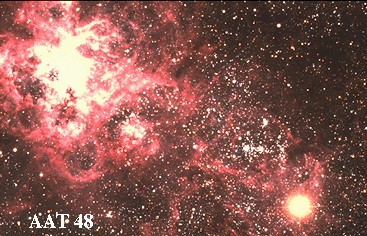
|
Credit & Copyright: Anglo-Australian Telescope
Board
Explanation:
In this close-up of the Large Magellanic Cloud,
the spidery looking nebula on the left is fittingly known as
as the Tarantula nebula. It is an
emission nebula
surrounding a cluster of hot, young stars
called the 30 Doradus super cluster. This
cluster may contain the most massive stars known (about 50 times
the mass of the Sun). Such massive stars put out
more than 100 times as much energy as our Sun.
The bright "star" (lower right) is actually
Supernova 1987a
and is a harbinger of things to come for the stars
within the Tarantula. Massive stars
burn their nuclear fuel at drastically enhanced rates to support
their high energy output. As a result their lives
last only a few million years compared to the Sun's few billions of years.
They end in a spectacular death explosion, a
supernova,
like the star which exploded in 1987 as seen above.
Supernovae may leave behind imploded stellar cores which
form neutron stars or
black holes.
|
January February March April May June July August September October November December |
| |||||||||||||||||||||||||||||||||||||||||||||||||||||||
NASA Web Site Statements, Warnings, and Disclaimers
NASA Official: Jay Norris. Specific rights apply.
A service of: LHEA at NASA / GSFC
& Michigan Tech. U.
Based on Astronomy Picture
Of the Day
Publications with keywords: supernova
Publications with words: supernova
See also:
- APOD: 2025 July 31 Á Supernova 2025rbs in NGC 7331
- APOD: 2023 October 11 Á NGC 1097: Spiral Galaxy with Supernova
- APOD: 2023 July 9 Á Doomed Star Eta Carinae
- APOD: 2023 May 22 Á Supernova Discovered in Nearby Spiral Galaxy M101
- Supernova Cannon Expels Pulsar J0002
- SN Requiem: A Supernova Seen Three Times So Far
- NGC 7814: Little Sombrero with Supernova
